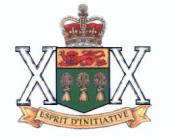
The Saskatchewan Dragoons are a reconnaissance regiment of the Canadian Forces Primary Reserve, located in Moose Jaw. The unit, part of 38th Canadian Brigade Group, Land Forces Western Area, traces its beginnings to the formation of the 95th Regiment of Canadian Militia on July 3, 1905, when Saskatchewan was part of the North-West Territories. The 95th Regiment consisted of eight companies, two of which, A and B, were located in Moose Jaw. On February 1, 1913, A and B Companies were expanded to form a new regiment designated the 60th Rifles of Canada. During World War I, the 60th Rifles contributed drafts of more than 5,000 soldiers to many units of the Canadian Expeditionary Force, including the 128th, 210th and the 46th (South Saskatchewan) Canadian Infantry Battalions from Moose Jaw. The 46th Canadian Infantry Battalion became known as the “Suicide Battalion” for its high casualty rate during the war.
The 60th Rifles of Canada amalgamated with the 95th Saskatchewan Rifles on March 15, 1920, to form the South Saskatchewan Regiment, which in 1924 was re-designated the King's Own Rifles of Canada. On December 15, 1935, the Regiment was the King's Own Rifles of Canada (MG) on absorbing units of the 12th Machine Gun Battalion. On the outbreak of World War II, the King's Own Rifles of Canada (MG) was mobilized for local protective duty. Many of its members transferred to 77 Field Battery, which was mobilized early in the war. A former KORC member, Major (later Lieutenant Colonel) D.V. Currie, won the Victoria Cross while serving with the South Alberta Regiment. The Moose Jaw armoury, the present home of the Saskatchewan Dragoons, was named in his honour in 1988.
On January 29, 1942, with its name reverting to the King's Own Rifles of Canada, the Regiment mobilized the 1st Battalion for home defence. The 1st Battalion was assigned to coastal defence duties in British Columbia until it was demobilized on March 30, 1946. Some elements of the 1st Battalion served with the joint Canadian-American Aleutian Islands invasion force, formed to fight the Japanese, who had occupied that part of Alaska. A 2nd Battalion served in the Reserve Army throughout the war. The King's Own Rifles of Canada became an armoured unit on April 1, 1946, and was designated the 20th (Saskatchewan) Armoured Regiment. It was renamed the Saskatchewan Dragoons (20th Armoured Regiment) on July 31, 1954. It is from this numerical regimental designation that the unit bears the Roman numeral “XX” on its cap badge. On May 19, 1958, the unit was designated the Saskatchewan Dragoons.
In 1970, the unit was reduced to the status of an independent squadron, “A” Squadron, the Saskatchewan Dragoons, with the remaining squadrons and the Regimental Band reverting to nil strength. A brief revival of the armoured role began in 1984 when the unit received an operational tasking and began to train with Cougars, a type of wheeled armoured vehicles. The Saskatchewan Dragoons currently operate a headquarters troop, an “A1” echelon (logistics support personnel) and reconnaissance troops in Moose Jaw, with another reconnaissance troop in Swift Current.
The Saskatchewan Dragoons have served in United Nations peacekeeping operations in Cyprus, the Golan Heights, Bosnia, and Croatia, and have provided emergency assistance during the Manitoba flood of 1997 and the battle against forest fires (Operation Peregrine) in British Columbia in 2003. Queen Elizabeth II approved the appointment of His Royal Highness the Earl of Wessex, KCVO, as Colonel-in-Chief of the Saskatchewan Dragoons on June 22, 2003. The Saskatchewan Dragoons perpetuate the 46th and 128th Battalions, CEF, and carry the sixteen battle honours won by the 46th Battalion in World War I.
John Chaput